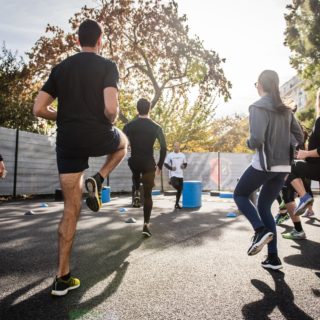Is Warm Up and Cool Down Necessary in Fitness?

What is Warm-up and Cool-down?
Warm-up and cool-down are slower-paced, reduced-intensity movements that precede and follow exercise. A warm-up before exercise builds gradually toward the pace and intensity of the exercise. A cool-down following activity, also called a warm-down, gradually returns the body to its resting state. Both the warm-up and cool-down place special emphasis on the muscle groups worked during the exercise session.
Warm-up and cool-down is a vital component of any fitness regimen, whether you are running, jogging, weight lifting, swimming, cycling or doing any sport activity.
All a warm-up requires is 5 to 15 minutes to improve the blood flow, aid in carrying oxygen to the working out muscles, preparing your muscles and nerves for a forthcoming workout, promote mobility and essentially fix your mind and body for the workout ahead.
Point to note;
- Avoid longer warming up if you are going for a high-intensity workout.
- Start slowly and give enough time to gradually blow up.
- Always practice deep breathing techniques during stretching exercises.
WARM-UP
Warming up before a workout is an important step toward injury prevention. A proper warm-up increases flexibility and blood flow to a given area, which limits the chance of a muscle pull and joint pain. Warming up also prepares your muscles to stretch during other exercises. For example, when doing any type of resistance training, tension is placed on the muscles. If the muscles are warmed up and able to stretch further, this will increase your range of motion and lower the risk for injury.
A good warm-up prepares your body for more intense activity. It dilates your blood vessels, gets your blood flowing, ensuring that your muscles are well supplied with oxygen. It raises your muscle temperature for optimal flexibility and efficiency, and increases your breathing rate. Warming up gives your body time to adjust to the demands of exercise. This can improve your performance and help you get the results you want.
By slowly raising your heart rate, the warm-up also helps minimize stress on your heart.
How long you spend warming up will depend on your fitness level. If you are newer to exercise, your body will respond better with a longer warm up. It should take about 5 to 15 minutes.
Adding dynamic stretches to your warm-up may improve your exercise performance. Dynamic stretches uses active movements to prepare muscles for exercise. For example, arm circles, shoulder flexion and extension, single leg swings, alternating knee hugs, standing hip circles, etc. Once your muscles are warm, spend a few minutes stretching. Since the goal of your warm-up is to increase your heart rate and get you ready for more intense work, choose stretches that can be done standing up. Floor stretches are best for your cool down segment.

Why Warm-Up is important ?
- Increasing heart rate to prepare the body for exercise or physical activity
- Increasing the circulation of blood flow, which increases the delivery of oxygen to the working muscles
- Ensuring muscles are supple and pliable, improving flexibility
- Important as a form of mental preparation
- Reducing the risk of injuries
Examples of Warm-Ups
- Going for a brisk walk, walk slowly for 5 to 10 minutes
- Going for a jog, walk briskly for 5 to 10 minutes
- A brisk walk or light jog before a run, gradually speeding up to one’s normal running pace
- Going swimming, swim slowly at first and then pick up the pace
- Pedaling a bike slowly with no resistance
- Moving joints and muscles through appropriate movement patterns such as jumping jacks and lunges before picking up weights for strength training
- Slow, sport-specific drills
COOL-DOWN
After exercise, your blood is heavy in your extremities and your heart rate is usually elevated. The purpose of the cool-down is to return your heart rate close to resting. Stopping quickly without a cool-down can result in light-headedness, dizziness and/or fainting. A good example of a cool-down is walking after running. Your cool-down should range anywhere from five to ten minutes.
Cool-down typically means to continue workout for another five minutes at a slower pace and intensity which supports you to relax the body.
Why is Cool-Down important?
- Allows the body to safely transition from exercising back to a steady state of rest
- Gradually reduces heart rate, breathing, and body temperature
- Helps muscles return to optimal length and prevents pooling of blood to certain extremities, which prevents your blood pressure from dropping too rapidly
- Helps prevent muscles soreness and stiffness and reduces risk of injury
- Removing waste products, such as lactic acid, from the muscles and preventing cramp. After intense exercise, lactic acid builds up within your system, and it takes time for your body to clear it out. Cooling down exercises (such as stretches) can aid this process of releasing and removing lactic acid, helping to speed up your body’s recovery post-workout.
- Preparing the body to for the next workout, whether that be the next day or in a week
How should I Cool-Down?
- Cooling-down should last between five and ten minutes and incorporate tapering off dynamic movements, such as a slow jog moving into a walking pace.
- Use static stretches when cooling down, which involves holding a stretch in a specific position for 5-30 seconds
- Stretch larger muscle groups (hamstrings, glutes, quads, chest, back) first then move into smaller muscle groups (shoulders, triceps, calves, biceps).
- Stretches should be held in a challenging but not painful position, while focusing on breathing throughout the stretch
- Take slow deep breaths while cooling down
Examples of Cool-Down
- After a brisk walk, walk slowly for 5-10 minutes
- After a high-intensity run, walk slowly for 5-10 minutes
- After swimming, slow the swim laps
- After weight lifting, stretch the muscles
- Stretching is recommended during the cool down period, as it improves range of motion.
Stretching
The best time to do static stretching is after a workout as part of a proper cool-down routine. Static stretching involves holding muscles in one position to increase flexibility after exercise. For example, chest opener, overhead triceps rich, biceps stretch, baby pose, forward fold, knee hugs, cobra pose, pigeon stretch, etc. The benefits of static stretching include relief from cramping, improved range of motion in the joints, decreased risk of injury and a decrease in the delayed-onset of muscle soreness. Stretching can also be very relaxing, both physically and mentally. It is most effective when you are in a relaxed and comfortable position. There will be some mild tension or discomfort while stretching, but don’t let it be painful.

Conclusion
Warm-up and cool-down exercises take just a few minutes and they make all the difference in your exercise regimen and support your body. Take enough time to gradually progress into the warm-up and then cool-down when you are done with your exercise regimen.



